This past Saturday, BBC simulcast the 50th Anniversary Special of Doctor Who, breaking Guinness records for just how far reaching the telecast was. But chances are, whether or not you even like Doctor Who, you already knew that. A lot of modern Who fans, or “Whovians” as they are often called, have a passion for the franchise that borders on frightening.
Were there a universally accepted scale to rank the relative annoyance factor of a fandom’s extremist wing, it’s safe to posit that Whovians have long since overtaken Trekkies and Harry Potter enthusiasts, comfortably occupying the number three slot behind Beliebers and Twilight mavens. For a long time, being a fan of Doctor Who was like being into the band Pavement. It signified one as a rarified geek who had cultivated an appreciation for more than just entry level nerd interests. Doctor Who was always something of an acquired taste. It’s basically a British sci-fi series about a man who time travels in a police box and fights aliens that look like R2-D2 if he died valiantly in a Bed, Bath & Beyond and was robotically revived with whatever household appliances happened to be nearby at the time. “Mainstream crossover appeal” wasn’t its strong suit.
The show ran continuously for nearly thirty years, going through seven leading men, shifting tones and styles, and experiencing waxing and waning waves of pop cultural relevance. After a much maligned US produced TV movie starring Paul McGann as the titular doctor fighting Eric Roberts of all people failed to spark a second coming of Whomania stateside, all was thought lost. The rakish Brit with the adorable coats and his charming screwdriver seemed destined to remain an archaic touchstone for a bygone era of geekdom.

Eccleston would have done more Who, but he had a pressing need to be involved in GI Joe: The Rise of Cobra.
Queer As Folk creator Russell T. Davies helmed a relaunch of the series in 2005 with Christopher Eccleston as The Doctor, an actor whose slick, leather jacket besuited appearace and elastic demeanor, easily shifting between dramatic menace and ebullient comedic relief, was the perfect man to bring the iconic hero into the 21st century. Doctor Who has always been a series that compensated for its budgetary limitations and garish visual style with clever plotting and idiosyncratic characterization, but showrunner Davies found smart ways to modernize the show’s structure and feel to endear new audiences to a franchise he had grown up loving. The ever-evolving zeitgeist of the global geek consciousness was more poised than ever to fall in love with a show like Doctor Who, now equal parts romantic space opera and madcap, farcical adventure series.
This new iteration of Doctor Who felt like John Byrne’s revamp of Superman, a hopeful beacon of a hero The Doctor has a lot in common with. The Doctor came from a race called the Time Lords, god-like beings who policed the entirety of the time stream. He was often painted as an iconoclast, as liable to be on the run from his peers as teaming up with them. The chief premise of Nu-Who was that there had been a Great Time War, between the Time Lords and their nemeses, the Daleks. It threatened existence itself, and the only way to end it was to destroy both sides, an unenviable task The Doctor saddled himself with. He was The Last of The Time Lords, now, and he carried with him an inherent pathos that made him more towering and tragic hero. This grief became a driving force throughout every mega-arc on the new series, freeing the series from decades of confusing continuity but shackling its protagonist with regret as metafictional penance.
When Eccleston left, making way for fan favorite David Tennant, things kicked into overdrive. No one had connected with the audience to this degree in the role since Fourth Doctor, Tom Baker, and that singular connection made the series popular all over. The BBC wised up and saw the potential of the devout, obsessive tumblr generation and marketed the show in the states through their BBC America channel to great success. Now, where it had once been an oddball curio at conventions, Doctor Who was becoming the geek gateway drug for a new generation. In the years that have passed since the beginning of the series relaunch, the TARDIS, The Doctor’s craft, is as likely to adorn messenger bags and hoodies as the Superman crest or Yoda’s face.
They’re here. They’re wearing fezzes. They’re not going away.
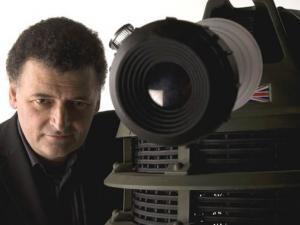
Moffat, with a Dalek. (Source: Den of Geek)
A few years ago, when Davies abdicated his throne as showrunner, taking “I don’t want to go” David Tennant with him, Steven Moffat, a scribe responsible for some of the revived series’ best scripts, took the reigns, bringing the young unknown Matt Smith in to take over the lead. The duo’s first episode “The Eleventh Hour” promised a more streamlined, cinematic take on the mythos, finding a happy medium between J.J. Abrams lens flare optimism and sharp, Ourobouros plot machinations. Moffat, a veteran of sitcoms like Coupling, was as fervant a fanboy as his core demographic. The audience, who had begun to grow tired with the limitations of Davies’ repetitive tropes as head writer, now had an advocate who was like them. Moffat, a man who can best be described as someone who has read The Time Traveler’s Wife entirely too many times, began focusing more on the knotty, self-reflexive interpretations of time travel logic. His stories took full advantage of the flexible nature of continuity, relying on closed loop theory as it’s own sort of deus ex machina.
This half of the Nu-Who era would see complicated arcs without catharsis or resolution and writers being guided by Moffat to approach episodes with a more high-concept, poster-driven mindset, leading to great-on-paper episodes like “Dinosaurs On A Spaceship.” Davies may have gotten grief for essentially retelling the same few narratives and relying on many of the same storytelling techniques, but Moffat’s reign became more and more controversial for its treatment of female characters and the tendency for his plotting to seem made up as it went along. Here at the tail end of Matt Smith’s run as The Doctor and with a giant, multi-Doctor anniversary special on the way, much of the fandom was split on whether or not the controversial showrunner was capable of delivering something satisfying, or if it would just be a half-baked smorgasbord of fan service, expensive eye candy and wankery.
Luckily for us, the mad Scot delivered.
Full disclosure, I once considered Steven Moffat one of my favorite working writers, in any medium, and the longer he was in charge of this show, the more and more seeing his name under a story credit frustrated and saddened me. It would have been very easy for all involved to fill their basket with Easter eggs, but winking nods only would have gotten so far. Continuing the story from the recent, baffling season finale of the regular series, likewise, would’ve been ill advised, considering how confounding it’s conclusion had been. Smartly, Moffat chooses to use the opportunity of the anniversary special much the way ongoing comic book writers use crossover events, by pausing the sequential goings on in favor of telling a big character moment using the theatrics and scope of a whizbang spectacle.
(Spoilers ahead.)
The mechanics “The Day of The Doctor,” bringing incarnations of The Doctor from different eras together for a single adventure, should be easy enough to grasp for anyone who grew up reading about Earth-2 in Justice League/Justice Society crossovers. Our current Doctor (Matt Smith) and his companion Clara get called in by UNIT, a government agency that has appeared in Who since the era of the Third Doctor, to investigate a mysterious painting that isn’t quite a painting. It seems The Doctor’s people, the Time Lords, had the technology to distill moments in time, and even beings, into these stasis frames, like living painting. Something nefarious has escaped from inside one such image, and Queen Elizabeth I has sent a message across history for The Doctor to investigate. (Okay, maybe it’s a little more complicated than Barry Allen challenging Jay Garrick to a race.) This gives Moffat the chance to bring back original series baddies, the shape-shifting crab people called the Zygons, and it provides a venue for Matt Smith to cross his own timestream to team-up with David Tennant, their surprisingly restrained interplay more than worth the price of admission.
The real treat of the special is the “other” Doctor who comes along for the ride. We’re introduced to John Hurt, bedraggled, shell-shocked and dripping with a preternatural kind of exhaustion. He plays an incarnation of The Doctor so fucked up that we’ve never even known about him until now. “The Doctor” isn’t just a name, but a promise, a pledge to perform no ill. This Doctor that Hurt portrays is The War Doctor, the man who single-handedly ended the Time War, the very act that has propelled the last eight years of Nu-Who. Technically, he premiered at the end of “The Name of The Doctor” and was officially introduced in the webisode “The Night of The Doctor” that saw Eighth Doctor Paul McGann reluctantly regenerating into the kind of warrior necessary to fight in the Time War. We meet him on the day he steals The Moment, an unthinkable weapon so powerful it grew sentience, and a conscience. We watch as The War Doctor struggles to ignite this archaic box before it springs to life in the convenient form of Rose Tyler, (Billie Piper) The Doctor’s companion from the first season of Nu-Who. The Moment gives him the Dickensian choice to see his future selves, to fully grasp the ramifications of what he is about to do.
Once all three Doctors are brought together, the show really gets going. So much of Nu-Who has been a peculiar brand of meta-fiction, with writers finding in story reasons for long standing aspects of continuity, and much of it has been wrapped up in what The Doctor did in The Time War. In reality, The Doctor has a companion because the dynamic adds to the drama, providing an audience fill-in for The Doctor to spout exposition to in new environments, or, sadly, to play a damsel in distress.* Nu-Who goes out of it’s way to present the companion as a necessity, because without a companion to be his conscience, he might, you know, commit double genocide and feel really shitty about it for eight seasons. By allowing The War Doctor to hash it out with Ten, a man whose grief over the war leads to Hamlet levels of angst, and Eleven, a man who’s largely moved past his regret by distracting himself and getting caught up in one impossible entanglement with a “mysterious” woman after another (Amy, River, Clara.)
At first, all of the arguing is in jest, and cute, with Hurt manifesting as the physical embodiment of Old Who, almost like the ghost of The First Doctor, William Hartnell, all old-timer criticism and hand waving tear downs. He mocks the younger actors’ quirky performance styles and seems to side-eye everything about the current incarnation of the franchise, giving Moffat a voice to address much of the criticism he’s come under recently. Creating that objective distance works for the story, and its exactly the kind of “what if?” fun that specials like this are supposed to trade in, but as the episode progresses, the dynamics shift in a very interesting way.
The interplay between the three actors is astonishing, and much of this works solely on their backs. Even though the descending ages of the actors goes from Hurt to Tennant to Smith, the actual character of The Doctor works in the opposite way. Hurt’s War Doctor is younger than Ten, and Eleven is even older than them both. Once the introductory shenanigans are out of the way, Smith gives his all as the wise old man hiding behind boyish, troubled eyes, shrugging off Tenant’s admonishment for moving past his Time War guilt. Matt Smith may be some forty years John Hurt’s junior, but Eleven has four hundred years on The War Doctor. The caliber and pedigree of the actors involved takes a comic book-y scenario and injects it with Shakespearean depth. If you’ve ever reading Infinite Crisis and see the scenes of Earth-2 Superman, Superboy-Prime and our Superman duking it out, then you have a fair estimation, just with British accents and suits, and less Johnsian literalism.
The main conflicit of the Zygons trying to take over the Earth is suitably simple, and largely forgettable, as it merely provides the backdrop for the greater morality play at hand. The structure of the episode is tightly paced, and the fan wank callbacks serve to mask set-ups for the resolution quite well, hiding in plain sight as it were. Nothing feels like a waste, and the even the hokier moments, namely the negotiations between UNIT and The Zygons, that might elicit eyerolls are well executed enough to be forgiven. The conundrum of the B-plot conveniently mirrors The War Doctor’s dilemma, so his future selves, unaware that they are dealing with a Doctor who has yet to make this fatal decision, try to one-up him, but in so doing accidentally convince him that he has no other choice but to complete his dreaded mission. Seeing how this regret fuels his future, he sees himself as a tragic martyr, the man who has to do the unthinkable so that future versions of him can be the great hero he doesn’t have the luxury of being.
Luckily, Ten and Eleven aren’t having that shit. So much of the series is built around The Doctor swooping in and saving other people, whipping out moral superiority tempered with idealist hope. “The Day of The Doctor” works so beautifully because, at it’s mushy center, it’s about The Doctor getting to go back and save himself. Taken at face value, it’s kind of goofy and sentimental, but the storytelling on display, fueled by some of the best acting I have seen on genre television in a long time, propel it to dizzying heights. It’s like someone blew that suicide intervention scene from All-Star Superman up to IMAX size and set it to Aerosmith’s “I Don’t Wanna Miss A Thing.” I defy you not to experience weapons grade FEELZ during the last act. The Doctors (all of them, thanks to cleverly deployed archival footage) band together, and perform a time altering act that, once explained, should have been blatantly obvious elsewhere in the episode, but it fits in line with Moffat’s closed loop paradox obsession in a way that actually feels right. By recontextualizing the defining moment that has served as the engine for Nu-Who for the better part of a decade, Moffat creates a new jumping point for the future of the series to take off on.
This anniversary special managed to celebrate half a century of a well loved series while simultaneously outfitting the franchise with a new pair of legs. I, for one, can’t wait to see where they run off to next.
* – Moffat has a troubling tendency to undercut the female protagonists of the show, treating them like plot devices or beings who exist solely to serve The Doctor’s arc, and here, Clara, Elizabeth I, the Brigadier and Osgood all are given ample time to shine on their own, and display the sort of autonomy and class that characters like Romana brought to the old series. Taken out of context, a scene of Clara opening a door the three Doctors just spent an entire scene trying to unlock using science is just a punchline, but coupled with other similar moments in this special and contrasted against the last two seasons of the series, marks some progress that will hopefully continue into the Peter Capaldi era.

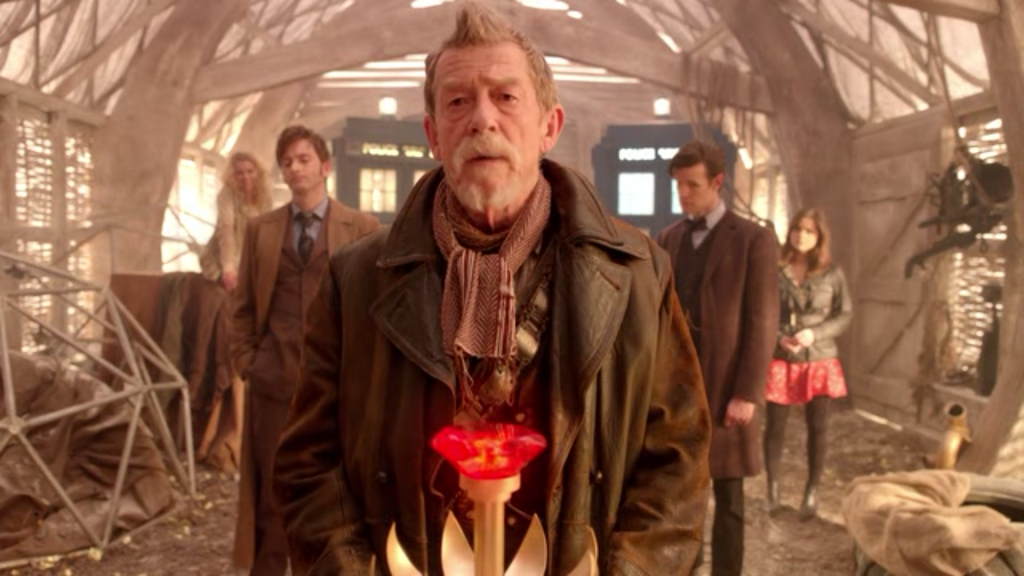
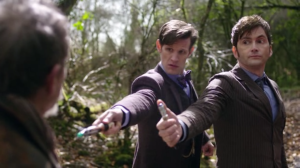
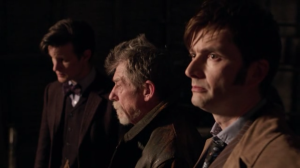
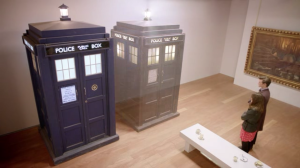
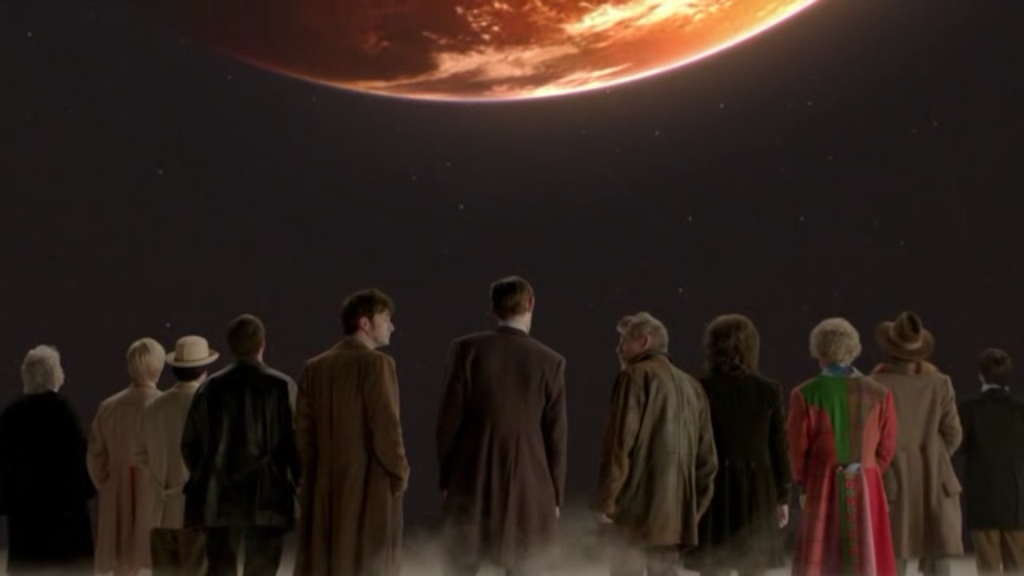

Love it!
Just wanted to paraphrase something I read from Moffat in one of the few post-DotD interviews that’s been put out there. He said that he started by asking himself; what was the most important day in the Doctor’s life? The clear answer was the day he destroyed Gallifrey. So he thought about that moment in the face of who and what the Doctor is, and concluded…of course he didn’t do it. He would never do it. So then the story became, why does he think he did it and what really happened that day?
Also, I see you mentioned the fantastic webisode “Night of the Doctor” but I also strongly recommend a parody video by Peter Davison (doctor #5), “The Five(ish) Doctors Reboot.” It’s 30 minutes, terribly funny, and has about 50 cameos of people who couldn’t be crammed into the 50th proper.
This 50th bonanza is really uniting the old and new series in my eyes and getting me more interested in the old…and that’s a good thing!